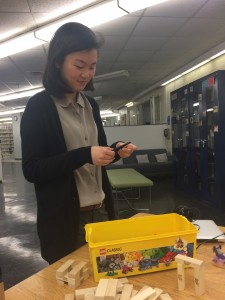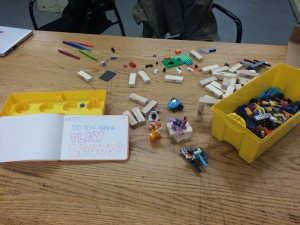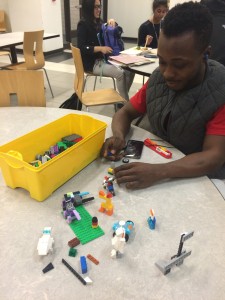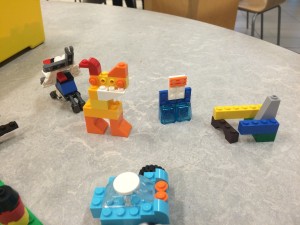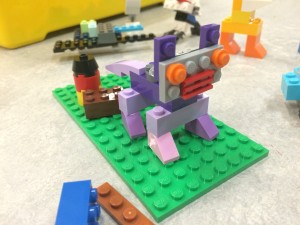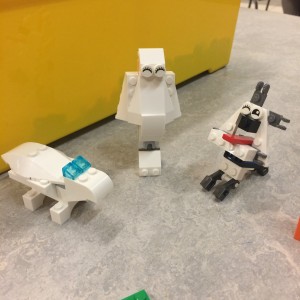January 27, 2016
by lnrossoni
0 comments
Thesis Stream of Consciousness Essay
What are your areas of interest in dynamic media?
I have always had an interest in making toys and games for myself, my brother, my friends. I remember not having a video game console for several years because of my parents being sure there is something better I could do with my childhood. So I read a lot and played with Legos, K’nex, model rockets, paper airplanes, drawing, climbing trees and damming streams. These activities made a strong impression on my later passions as a designer, which is that I am very capable of making my own fun and entertainment, using everyday things around the house, being resourceful with objects and other toys to make new games and fun/ny interactions.
I have seen toys as a dynamic media, where the user gets to choose how they interact with this object: is it placed carefully in a frozen battle scene on a chest of drawers, or thrown haphazardly out the window with a plastic bag as a parachute? (I have done both of these scenarios). Toys have been a conduit for channeling my creativity, and to cultivate and share this experience for others has been my passion for a long time.
My interest in improv comedy began in high school, where I tried out for an improv club my freshman year and got in. I learned that improv is a lot more than making up stuff randomly and hoping that it’s funny. There is a craft and process that goes with forming characters, environments, and scenes. As funny and creative one person could be, it takes a team of people to make a scene work. Listening and supporting your team member is often the unsung hero of a good scene. As I went into college, I followed my interest in improv and humor and learned more about making and breaking patterns in a longform scene, where ideas (called bricks in improv lingo) could be used repeatedly in different scenes to make similar jokes in different contexts (callbacks). Experimenting with different formats of scenes and improv games made me think of how it relates to design. Don’t families of products have different forms but similar details that make them identifiable as a collective? The creative processes in design and improv also have similar steps taken to reach a conclusion, whether that is a funny scene/sketch or a successful design. Both start with a source of inspiration and divergent thinking, where ideation and brainstorming make a whole crop of diverse ideas stemming from a single word or scenario. From the whole crop of ideas, the improvisers/designers pick ones that look the most promising in yielding a successful idea, whatever successful means to a designer or improviser. With these concepts, the designers start to hash out the details of the product, how it will look/operate/be distributed/etc. Improvisers use the ideas and play out a scenario with the inspiration as a foundation to build a scene. Specificity, honesty, and adaptability is key for team members in both situations.
When it comes to technology as entertainment, I have trouble balancing the positive and negative effects of its potential time and energy commitment. On one hand, technology and dynamic media can bring immersive environments and engaging interactions that can be portable and scalable to various populations. Video games and social networks are prime examples of mainstream dynamic media. On the other hand, these platforms are specifically designed to hold our attention, and making them as engaging as possible makes it all the more addictive and satisfying to use. Last semester in design seminar, our discussions on technology, communication, and design enlightened me on how these issues have both helped and disrupted day to day life of those users. As an aspiring toy and game designer, I bristle at the thought of designing something like a Candy Crush Saga, a mobile game that I see as nothing more than an interactive screen saver…anti-productive fluff. I am interested in interactive experiences that leave the user feeling empowered in their unique abilities, rewarded for thinking outside the box, or even making a new box to play around in. I think dynamic media has a lot of potential in creating vastly different experiences with the same foundation, and it makes me excited to think about how someone else may do something wildly different when provided the same stimulus as another person, just like two different teams of improvisers or designers coming up with wildly different solutions or stories when given the same foundational idea.
I was listening to an episode of RadioLab when I came across an interesting story about how play can be used for entertainment and learning. Dmitri Mendeleev (creator of the periodic table) had trouble coming up with a way to organize all of these newly discovered elements. He had put each element on a card, along with some information like its atomic weight, atomic number and so forth. Then, he would play around in organizing these cards in different arrangements, shuffling them together, and trying different ways. It was through this process of playing and lateral thinking that he came across the configuration of elements in the periodic table we know today.
This idea of using play to facilitate creative thinking leading to mental, physical, and even scientific discovery is something I am very passionate about. The systems for teaching and learning in school are still based on linear thinking and strategy to accomplish a singular goal, be it a science project, math problem, or essay. I think there is a lot of room to grow in encouraging lateral (creative) thinking and topical association in a teaching environment. I believe there can be more flexibility in integrating creativity in school, starting with encouraging the importance of creativity on the same level as intelligence. Not all problems are solved in a linear or direct fashion. Many discoveries were made through curious observation of coincidental occurrences, and even through pure accident. I think it should be noted that although these inventors were unintentional in causing these discoveries, they were confident enough in pursuing their curiosities to make something new and useful. Creating systems about adapting to the unexpected and embracing the ridiculous is crucial in empowering people to think critically and have the abilities to make something from their discovery.

